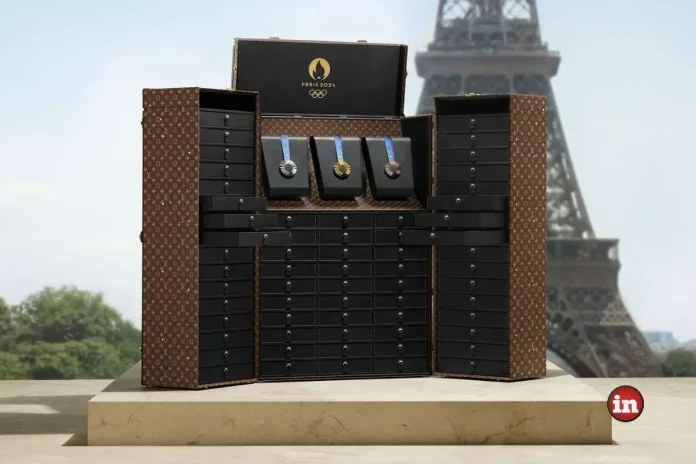For long now, Louis Vuitton (LVMH) has been seen as an elusive, ultra-luxury brand out of reach for all, but the deepest of pockets. But over the course of the Paris Olympics, one couldn’t help but see the brand everywhere. As the €150-million sponsor of the Olympics, they were visible everywhere, with Louis Vuitton trunks adorning the opening ceremony, medals doled out by Chaumet, and even the celebrations featuring Moët & Chandon.
So what gives, and why is LVMH so hell-bent on being seen everywhere and by everyone?
The Challenging Luxury Landscape
The context for LVMH’s bold moves is stark. After surfing a pandemic-era luxury boom, the group has encountered significant headwinds. Third-quarter sales dropped 3%, primarily driven by diminishing demand in key Asian markets like China and Japan. Investors have taken notice, with LVMH’s shares losing more than a quarter of their value since March, now trading at €596.
The most concerning trend is the pullback of wealthy Chinese consumers. Shaken by economic uncertainties and a property market crisis, these once-voracious luxury buyers are now carefully reconsidering high-ticket purchases. For a brand like Louis Vuitton, whose luggage can cost £47,000, this represents a substantial challenge. The numbers are sobering: a 14% sales decline in Asia during the second quarter, following a 6% drop in the first three months of the year.
Faced with cooling luxury markets and wavering consumer confidence, the company is leveraging sports as a powerful new growth strategy—turning Olympic stadiums, Formula One racetracks, and football pitches into global brand amplification platforms.
The Olympic Masterstroke
LVMH’s sports strategy began with a spectacular Olympic campaign. At the Paris 2024 Games, the company didn’t just sponsor the event—it comprehensively dominated it. From Chaumet-designed medals presented on Louis Vuitton trays to Berluti-outfitted French athletes and a Louis Vuitton trunk carrying the Olympic torch, LVMH transformed the Games into a massive brand showcase.
The media exposure was unprecedented. In pre-event materials, LVMH and its brands were mentioned 50 times—even outpacing France’s national motto of “liberty, equality, fraternity.” Tracking firm Launchmetrics noted that Dior and LVMH garnered outsized media impact value during Paris 2024. While Dior was the most discussed brand of the Games, multiple LVMH brands ranked in the top 20. That surely counts as a gold medal in LVMH’s books.
Formula One: A Global Playground
Building on Olympic momentum, LVMH has now secured a landmark 10-year, estimation billion-dollar sponsorship with Formula One. This isn’t a typical sponsorship but a multi-brand invasion from all the group brands at LVMH. TAG Heuer will replace Rolex as the official timekeeper, Louis Vuitton will manufacture trophy cases, and Moët & Chandon will replace Italian sparkling wine on victory podiums.
The timing is strategic. Formula One has undergone a remarkable transformation, attracting younger, more diverse audiences through Netflix’s “Drive to Survive” series after the acquisition by Liberty Media. The sport has expanded from one to three American races—a crucial market for LVMH—and dramatically shifted its demographic appeal. And this isn’t the only sporting arena it has eyes on.
Football: A Potential Local Legacy
The group’s latest move involves purchasing a controlling stake in Paris FC, a lesser-known football club. While it might seem like a passion project, industry experts suggest it’s a nuanced strategy. Greater Paris has 12 million people, but only one prominent football club in Paris Saint Germain. By investing in Paris FC, LVMH could tap into local talent, create a strong community identity, and potentially gain a foothold in a neglected market.
With five children all working in the business, these sports deals might also serve as a strategic mechanism for maintaining family harmony. By creating opportunities for different family members to shine—like sons Frédéric and Jean driving the F1 deal—Arnault might be skillfully managing potential succession tensions.
The Broader Context
Clearly, LVMH has had a change in strategy as a changing of the guard looms. The sports investments aren’t just about logos or sponsorships—they’re about creating emotional, experiential connections. In today’s market, powerful brands must be “everywhere”—not just in stores, but in entertainment, Netflix, sports, and cultural moments.
Arnault’s strategy has always been about expansive, forward-thinking growth. From small regional brands selling to elite customers, LVMH has transformed into a global empire by constantly reimagining its market approach. The sports investments represent a sophisticated understanding that luxury consumers now seek more than just expensive items—they want stories, connections, and cultural relevance.
As wealthy markets become more competitive and traditional luxury consumption evolves, LVMH is positioning itself not just as a product manufacturer, but as a curator of global experiences. Sports provide a universal language that transcends traditional marketing boundaries.
A Calculated Gamble
LVMH’s sports strategy is a calculated evolution. By embedding its brands in global sporting narratives, the company is creating new pathways for growth, engagement, and brand perception.
By moving luxury from exclusivity to a greater degree of inclusivity and ensuring the brand’s aspirational nature envelopes more people than ever. The playing field has changed, and LVMH is making sure it’s not just a participant, but a game-changer in the arena of sports and business.


